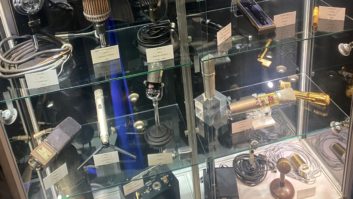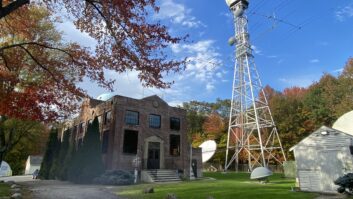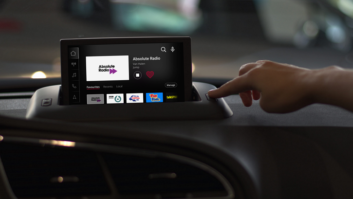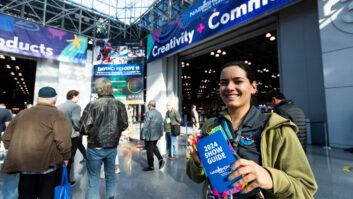The annual Audio Engineering Society show is a favorite for many engineers for its sheer variety of audio topics. Not only are there broadcast technology-oriented sessions but one can find things to learn from other audio disciplines. Of particular interest may be a series of audio equipment building and refurbishing workshops.

And there are always some fun sessions as well.
The Broadcast & Online Delivery track reflects the changes in content and work methodology buffeting the radio industry. There are multiple sessions on podcast production and AES67 audio and IP audio networking.
WEDNESDAY
Timely, to say the least, is the Wednesday session “Broadcasting in Emergency Situations: It Can Happen to You … Because It Happened to Us.” Bonneville International’s Jason Ornellas and Emmis Broadcasting’s Alex Roman recount their experiences with extreme weather.
For those wanting to branch out in the growing IP audio world, Yamaha’s veteran digital audio network specialist Patrick Killianey will provide something of an IP Audio Network 101 with “Network Fundamentals for Audio Engineers.”

For those wanting to join the podcasting parade there will be a pair of podcasting sessions, “Podcast Production Roundtable,” led by Minnesota Public Radio’s Rob Byers; and at the end of the day, “Podcast Production.”
THURSDAY
Leading off, familiar faces can be seen at the session “Techniques for Success With AoIP Technology.” Kirk Harnack moderates a panel made up of Andreas Hildebrand, Gary Kline, Greg Shay, Kent Terry and Christopher Tobin.
Patrick Killianey will continue his IP audio tutorials with “Optimizing Networks for Media.”
Dave Bialik, organizer of the Broadcast & Online Delivery track, takes on a topic of growing importance in “Standardizing Streaming Audio Descriptive Metadata.”
Bialik returns for “Loudness for Streaming,” with panelists Thomas Lund, Frank Foti, John Kean, Mike Smith, Robert Bleidt and Sam Sousa. He says they’ll be discussing “loudness and processing concerns — trying to find the good levels for mobile while taking into account PCs and smart speakers.”
He adds they’ll also look at “trying to deal with injected material and whether can metadata reliably control loudness levels.” They’ll address the question, “Why does a radio station stream have to sound the same as the air product?” in addition to mulling AES loudness recommendations for streaming.
Taking advantage of the New York location, veteran journalist and RW contributor Scott Fybush heads up a look at “Modern Transmission Facilities.” His panel will include Jim Leifer of tower company American Tower, John Lyons of Durst Broadcasting and Shane O’Donoghue of the Empire State Building.
FRIDAY
The NAB’s David Layer heads up “The Future of Mobile Audio Delivery to the Consumer — Home & Mobile,” which promises to be a broadcast futurist’s favorite or most feared session.
Following a bit more in the traditional radio scheme is an intriguing-sounding session, “Building a Modern Broadcast Facility in a 152-Year Old Building.” Jimmy Buff and Kale Kaposhilin of WKNY(FM) will explain their work in turning an historic six-sided building into a radio studio. Well-known studio designer John Storyk has been commissioned for the job and he will also be on hand.
Another interesting session will require leaving the convention center. “80th Anniversary of The Mercury Theater’s ‘War of the Worlds’” will feature historical context from Frank Beacham along with select reenactments with Sue Zizza, David Shinn, the HEAR Now Festival and Voicescapes Audio Theater. There will also be excerpts from newly remastered recordings of the original broadcast and more. The event is hosted by New York Public Radio.
OTHER ITEMS
There will be equipment-building workshops on Thursday and Friday, with special interest on Saturday, which might be more appropriately called “Workshop Saturday.” The Boston section of the AES is overseer for this effort.

There will also be a surfeit of star recording engineers/producers at sessions and events including Bob Ludwig, Al Schmitt, Danny Kortchmar, Ed Cherney, George Massenburg, Chuck Ainley, Frank Filipetti and Elliot Scheiner. Speaker design guru John Meyer will deliver the Richard C. Heyser lecture. For history buffs looks at Dolby Labs, Shure and Bell Labs top the offerings.
On Saturday, SBE certification tests are offered.
On behalf of the Audio Engineering Society, it is my pleasant duty as Secretary to inform you that the Board of Governors has voted to grant you the Distinguished Service Award for over three decades of service to AES convention committees and the creation and development of the conventions’ broadcast track. Congratulations.
As is our custom, you have the opportunity of accepting your Award during the Awards Ceremony at either the 145th Convention in New York on Wednesday, October 17, 2018, or at the 146th Convention in Dublin on Wednesday, March 20, 2019.
IP AUDIO

The busiest man at the AES Show may very well be ALC NetworX technology evangelist Andreas Hildebrand, an expert on IP audio networking technology.
Radio World: How many sessions are you a panelist on?
Andreas Hildebrand: I am participating in three sessions as panelist and will run two further sessions as a presenter/host. Most sessions are touching on topics related to AES67 and the new SMPTE ST2110 standard. While some sessions are explaining some technological fundamentals, others are more centered around practical experience or discuss the impact of these standards on the wider industry. While all of these are sessions hosted by the AES conference, I will have at least four more presentations on the AES AoIP Pavilion stage, which is co-hosted by AIMS (Alliance for IP Media Solutions) and is located on the show floor, thus being accessible to all participants (no extra conference pass required).
RW: IP networking and AES67 are hot topics at the show and in the radio broadcast industry. Radio engineers attending the show have many tempting sessions and their time at the show is limited. Can you recommend one session you are involved in that they should make time for?
Hildebrand: For radio engineers who are looking for a more general overview on the standards scene and its potential impact, I recommend they attend session NA06 — “Interoperability Standards for IP Media Networking” [Friday, 9 a.m.] where Kevin Gross (the “father” of Cobranet and AES67) and Mike Cronk, chairman of AIMS will join me on the panel.
Those who are looking for more practical advice may be interested in B05 — “Techniques for Success with AoIP Technology” [Thursday, 9 a.m.] run by my good friend Kirk Harnack from Telos Alliance, or they should consider attending NA08 — “Real World AES67” [Friday 1:30 p.m.] which provides insight in and tips and lessons learned from recent projects. This session is also supported by EBU, the European Broadcasting Union.
And, finally, more technically-oriented engineers may want to look for deep insights into underlying technologies by attending NA05 — “AES67/ST2110 Technical: Synchronization and Redundancy” [Thursday, 4:15 p.m.]. Don’t forget to check the schedule of the AES AoIP Pavilion stage, which features a lot of topics around networking at shorter presentation time; 30 minutes per session.
RW: What is the latest on the IP audio or digital audio front that radio engineers should be aware of?
Hildebrand: While audio networking and AES67 are around for quite some time now, engineers should be aware of the new SMPTE ST2110 standards. While SMPTE at first glance sounds more oriented towards the needs of the TV industry, audio is of course an essential part of their production environment. Luckily, SMPTE has chosen AES67 as their foundation for the audio transport within ST2110, yet subtle differences exist.
Furthermore, while AES67 touches on linear PCM audio only, ST2110-31 defines bit-transparent transport for AES3 signals (including transport of AES/EBU metadata bits as well as any nonlinear audio format which can be transported across an AES3 line, i.e. Dolby E).
Another activity to watch is the Networked Media Open Specifications work conducted by Advanced Media Workflow Alliance, which covers functionalities required for full production system operations beyond what is being defined in AES67 or ST2110 (i.e. discovery and registration of devices and sources, connection management, network management, security etc.). The emerging keyword to watch for is “Full Stack” implementation.
DISASTER PREPAREDNESS

Jason Ornellas, market chief engineer for Bonneville Sacramento, has been up close and personal with events most engineers may never encounter. He’ll be a panelist for Wednesday’s “Broadcasting in Emergency Situations: ‘It Can Happen to You … Because It Happened to Us’” session starting at 9 a.m.
Radio World: What is your session’s purpose?
Jason Ornellas: Describing what it was like for us broadcast engineers during emergency situations like Hurricane Sandy, Harvey as well as the recent California wildfires. Our stories are first-person, as we were the ones on the front line helping and maintain our broadcast operations in which our community and listeners needed us the most and how we handled it.
RW: What might be a good takeaway for radio engineers?
Ornellas: Radio engineers are known for their tips and tricks to maintain and keep a station on the air in an emergency or not. It’s what we do. This session will cover how we prepped for these events, what we went through during and how we recovered. This is our story, featuring the folks who had their boots on the ground during these emergency disaster situations.
RW: Radio engineers at the AES Show have many tempting sessions and events to attend — why should they choose to attend the session that you are participating in?
Ornellas: This session hits home. It is definitely not about the newest trend in technology or about the latest AES standard or about virtual studios, but it is about real-world scenarios. For those of us radio engineers, Mother Nature and natural disasters definitely keep us on our toes when our broadcast operation is in line with its path of destruction. This will give you an idea how to prepare, what to think about that you may not have and build backup facilities since it has happened to us, it could happen to you.
TRANSMISSION FACILITIES

Scott Fybush will head up a session looking at high-profile transmission facilities in New York. “Modern Transmission Facilities” takes place on Thursday, starting at 4:30 p.m.
Radio World: What is your session and what should attendees expect?
Scott Fybush: In “Modern Transmission Facilities” we’ll be discussing the state of the art when it comes to broadcast transmission systems and the facilities that house them.
RW: Who’s joining you?
Fybush: The people in charge of the three big multi-user skyscraper facilities in New York — Shane O’Donoghue from the Empire State Building and John Lyons of the Durst Organization, which runs 1 World Trade Center and 4 Times Square. And Jim Leifer from American Tower, one of the biggest commercial tower leasing companies in the country.
RW: The location of the show provides you with a great opportunity.
Fybush: New York City is a unique place for broadcasting with all kinds of interesting challenges and expenses. But the lessons New York’s broadcasters have learned extend to smaller markets, too. There’s so much to learn from Shane and John about how to make facilities resilient and efficient.
RW: AES Show attendees are very busy and have many sessions to choose from. Why should they devote time to your session?
Fybush: This facet of broadcast engineering is going through tremendous change right now. The TV repack is forcing many FM stations to find auxiliary facilities or rebuild existing sites. After decades of using almost exclusively air-cooled transmitters, FM broadcasters are beginning to embrace liquid-cooled designs. STL technology is changing, too. Keeping on top of all these changes can be challenging, which is why attendees need to hear from these top experts in the business.

IF YOU GO
What: AES New York 2018
Where: Jacob K. Javits Convention Center
When: Oct. 17–20, 2018
How: www.aes.org/events/145/
How Much: Four-day all-access, $620 member/$755 nonmember; various packages available. Single-day all-access, $230 member/$285 nonmember. Exhibits Plus badge, $50–75






